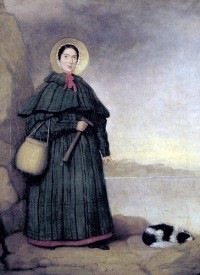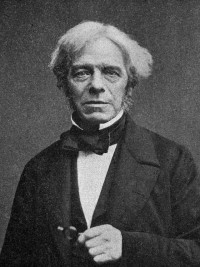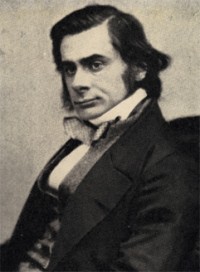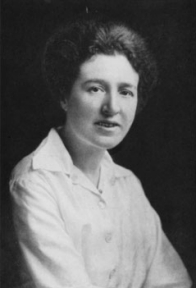
Agnes Arber. An article in the Annals of Botany from 2001 suggests this image was taken ca. 1916 or 1917 (Image: Wikimedia Commons)
Agnes Arber was a British botanist and historian of her subject. In 1946 she became the first female botanist – and the third woman overall – to be elected a Fellow of the Royal Society of London, one of the oldest and most esteemed scientific institutions in the world. Not only did this acknowledge Arber’s pioneering research and keen intellect, but it represented a milestone in the recognition of women in science.
Arber’s research focused upon the monocotyledons (often called the ‘monocots’), one of the two major groups of flowering plants (the other being the dicotyledons, also known as ‘dicots’). Arber’s first break-through was in 1912 with the award of a one-year research fellowship at Newnham College, Cambridge where she was given space in the Balfour Laboratory to conduct her research. It was then that she published what has become her best known work Herbals: Their origin and evolution. The book – which is now regarded as a classic and is still in print today – was a reflection of her interest in the history of botany, something that was also manifest in a number of fascinating biographical papers that she wrote on early botanists and naturalists such as Nehemiah Grew (1906), Guy de la Brosse (1913) and John Ray (1943). It should also be noted that Arber was a highly skilled artist, illustrating the majority of her books and papers.
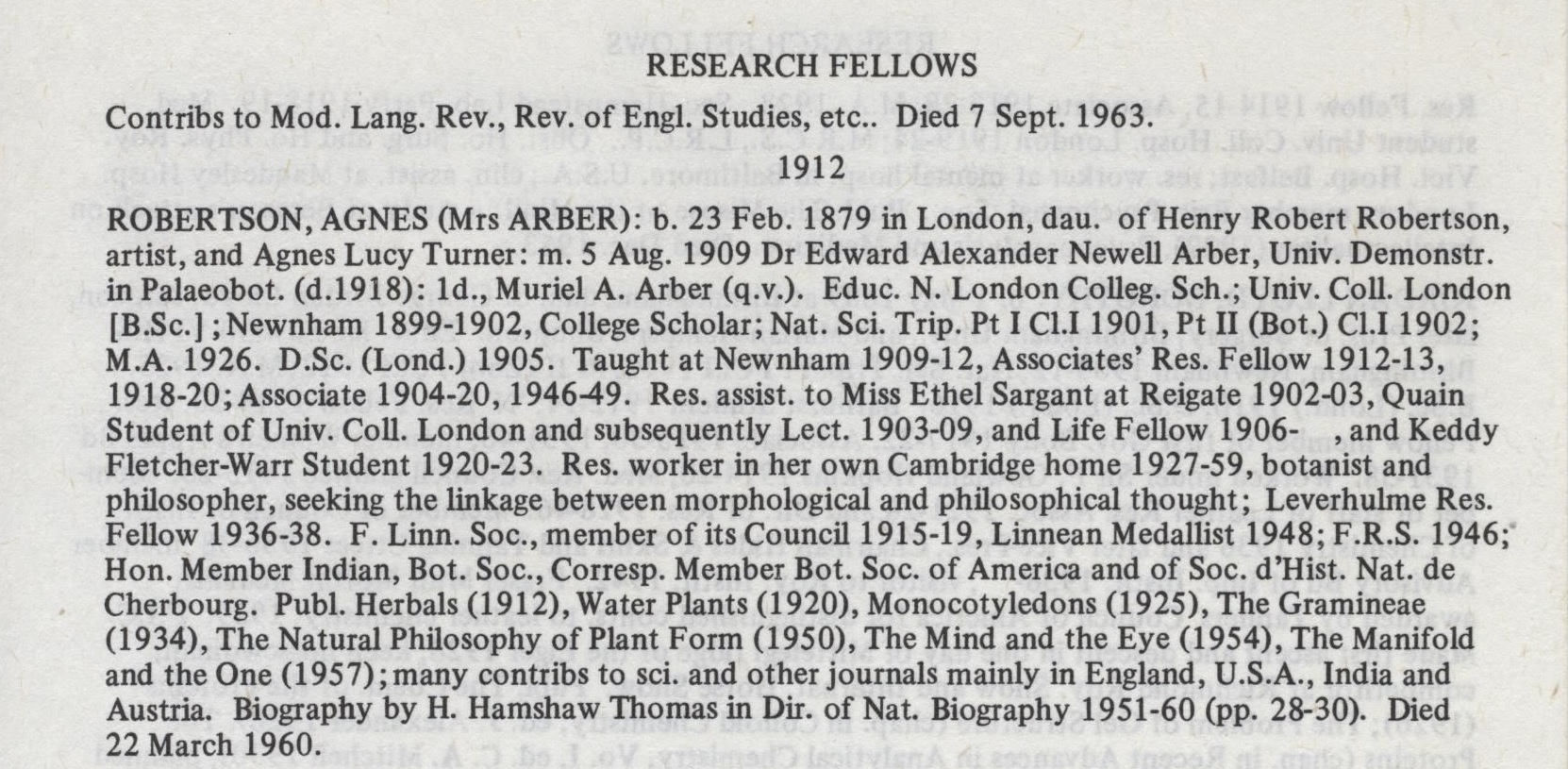
Agnes Arber’s entry from the printed College register of Newnham College, Cambridge (Image: Used with permission from Newnham College, University of Cambridge)
Arber also conducted research into the morphological differences of aquatic plants. This became the subject of her second book Water Plants: A Study of Aquatic Angiosperms which was published in 1920. After the publication of her third book The Monocotyledons in 1925, Arber turned her research interests to the Gramineae, that is the grasses and so of central importance to us. This work resulted in her fourth and final book The Gramineae in 1934.
Arber continued to work in the Balfour Laboratory until its closure in 1927. With no space for her to continue her work in the University’s Botany School, she set up a small laboratory in a bedroom of her own house. As an aside, there is an echo of Ronald Fisher in this behaviour, the renowned evolutionary biologist (also at Cambridge) who similarly used a bedroom in his home as a make-shift laboratory. From that point onward, Arber’s house became the centre of operation for her academic research, and aside from a few small research grants, her work was undertaken without financial support from a professional institution. During World War II, the supply situation was so dire that it became too difficult for Arber to maintain her home laboratory so she turned her intellectual pursuits to philosophy and history of science.
Maura Flannery (2005, p.14) sums up the importance that Arber placed upon philosophy: “She sees philosophical reflection as important work because only when the larger implications of research are understood can its real value be appreciated and the scientific endeavour truly enriched.” This statement is all the more powerful when one considers that Arber, a botanist, had written her finest philosophical works at a time when philosophy of science was dominated by physicists.
One reason that many ‘forgotten heroes’ of science drifted into obscurity is not because their work lacked scientific merit, but because their writing style was largely inaccessible to a lay audience. The palaeontologist Richard Owen is a good example of a scientist who produced some fine pieces of research, but whose writing style was, arguably, so tedious to read that people often did not bother. However, this is certainly not the case with Arber. Arber wrote with an effortless fluidity, intelligent and concise, along with a succinct and accessible style. Her work remains a pleasure to read. Indeed, Arber’s original works can still be read and enjoyed by a modern audience, which makes her obscurity all the more puzzling. So, what is the reason that so few people have heard of Agnes Arber?
In her eloquent overview on Arber’s contributions to science, Flannery (2005) suggests that it is because she has for so long been labelled as ‘anti-evolutionary’. This is all the more unfortunate because it is incorrect. As Flannery (2005, p.15) explains, Arber was not anti-evolutionary and did not refute the fact that species change over time, rather, she questioned “..the idea that natural selection is the dominant mechanism for that change”. Specifically, Arber believed that parallelism – today more commonly known as ‘convergent evolution’ – had a substantial impact on biological form that wasn’t taken into account by Darwin’s theory of evolution by natural selection.
It should be remembered that the 1940s and 1950s were a time when natural selection was widely embraced as the overarching answer to every question about biological life, when in reality there were many scientists, including the eminent biologist D’Arcy Thompson, pointing out that the evolutionary process was more complicated than could solely be accounted for by natural selection alone. Yes, natural selection is a critical factor, but there are other biological, genetic and physical processes at play too. None of these ideas refute the role of natural selection, rather, they are complimentary to it.
However, for a scientist to be branded ‘anti-evolutionary’ is often a nail in the coffin with regards to historical visibility. Once forgotten, the possibility is that it may have been an unjustly driven nail in the first place and so it becomes all the more difficult to acknowledge and thus remove.
As succinctly summed up by Flannery (2005, p.13) “The very fact that Arber achieved scientific recognition despite the lack of an academic position speaks highly of her research and also speaks to the place of women in British science in the first half of the 20th century.”
Text copyright © 2015 Victoria Ling. All rights reserved.
References
Arber, A. (1906) Nehemiah Grew and the study of plant anatomy. Science Progress 1, 150-158.
Arber, A. (1912) Herbals: Their origin and evolution. Cambridge University.
Arber, A. (1913) The botanical philosophy of Guy de la Brosse: A study in seventeenth-century thought. Isis 1, 359-369.
Arber, A. (1943) A seventeenth century naturalist: John Ray. Isis 34, 319-324.
Flannery, M.C. (2005) Agnes Arber in the 21st century. The Systematist 24, 13-17.
Packer, K. (1997) A laboratory of one's own: The life and works of Agnes Arber, F.R.S. (1879-1960). Notes and Records of the Royal Society of London 51, 87-104.
Schmid, R. (2001) Agnes Arber, nee Robertson (1879-1960): Fragments of her life, including her place in biology and in women's studies. Annals of Botany 88, 1105-1128.
Thomas, H.H. (1960) Agnes Arber. 1879-1960. Biographical Memoirs of Fellows of the Royal Society 6, 1-11.



